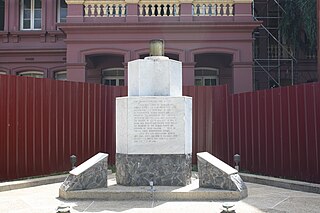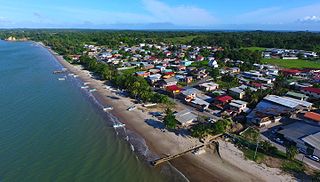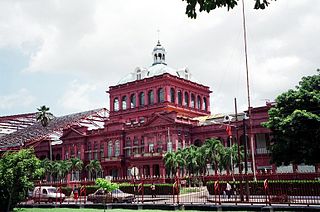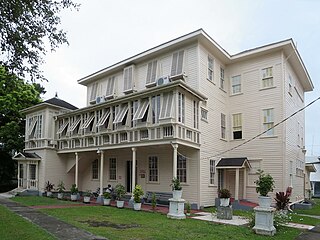The history of Trinidad and Tobago begins with the settlements of the islands by Indigenous First Peoples. Trinidad was visited by Christopher Columbus on his third voyage in 1498,, and claimed in the name of Spain. Trinidad was administered by Spanish hands until 1797, but it was largely settled by French colonists. Tobago changed hands between the British, French, Dutch, and Courlanders, but eventually ended up in British hands following the second Treaty of Paris (1814). In 1889, the two islands were incorporated into a single political entity. Trinidad and Tobago obtained its independence from the British Empire in 1962 and became a republic in 1976.

Port of Spain (officially the City of Port of Spain, is the capital of Trinidad and Tobago and the third largest municipality, after Chaguanas and San Fernando. The city has a municipal population of 49,031, an urban population of 544,949 and a transient daily population of 250,000. It is located on the Gulf of Paria, on the northwest coast of the island of Trinidad and is part of a larger conurbation stretching from Chaguaramas in the west to Arima in the east with an estimated population of 600,000.

Tobago is an island and ward within the Republic of Trinidad and Tobago. It is located 35 kilometres (22 mi) northeast of the larger island of Trinidad and about 160 kilometres (99 mi) off the northeastern coast of Venezuela. It also lies to the southeast of Grenada.

A water cannon is a device that shoots a high-velocity stream of water. Typically, a water cannon can deliver a large volume of water, often over dozens of meters. They are used in firefighting, large vehicle washing, riot control, and mining. Most water cannons fall under the category of a fire monitor.

Arthur Napoleon Raymond Robinson, was a Trinidadian and Tobagonian politician who was the third president of Trinidad and Tobago, serving from 19 March 1997 to 17 March 2003. He was also Trinidad and Tobago's third Prime Minister, serving in that capacity from 18 December 1986 to 17 December 1991. He is recognized for his proposal that eventually led to the founding of the International Criminal Court.

The Borough of Chaguanas is the largest municipality and fastest-growing town in Trinidad and Tobago. Located in west-central Trinidad, south of Port of Spain, north of Couva and San Fernando, and named after the indigenous tribe who originally settled there, it grew in size due to its proximity to the Woodford Lodge sugar refinery. It remained a minor town until the 1980s when it began to grow rapidly as it drew people for its bargain shopping and moderately priced housing. Its rapid growth has seen property values increase dramatically, however.
Karl Terrence Hudson-Phillips, ORTT, QC was an Attorney-General of Trinidad and Tobago and a judge of the International Criminal Court. He was also lead counsel in the murder trial of Grenadian Prime Minister Maurice Bishop.

Trinidad and Tobago are continental islands with a geologically very recent history of direct land bridge connection to South America. As a result, unlike most of the Caribbean Islands, Trinidad and Tobago supports a primarily South American flora and fauna and has greater diversity of plant and animal species than the Antilles. However, rates of endemism are lower than in the rest of the Caribbean because there has been less time for genetic isolation from mainland populations because of the history of land bridge connections and hence fewer opportunities for speciation, and so a greater proportion of the species in Trinidad and Tobago are also found on the South American mainland. Trinidad is nearer to mainland South America and has been directly connected to the mainland via land bridges more often and for longer periods than Tobago. This, as well as Trinidad's larger size and more varied topography and hydrology compared to that of Tobago allow greater species and ecosystem diversity on the former compared to that on the later of the islands.

The Jamaat al Muslimeen coup d'état attempt was an attempt to overthrow the government of Trinidad and Tobago, instigated on Friday, 27 July 1990. Over the course of six days, Jamaat al Muslimeen, a radical extremist Islamist group, held hostages at the Red House and at the headquarters of the state-owned national television broadcaster, Trinidad and Tobago Television (TTT). On 1 August, the insurgents surrendered. They were charged with treason, but were ordered released by the Court of Appeal. Twenty four people were killed and many more were injured in the coup.
Social unrest has shaped the development of Trinidad and Tobago since the middle of the 19th century. Attempts by the British colonial government to crack down on the celebration of Carnival sparked the Canboulay Riots in 1881 and 1884. Attempts to control the celebration of Hosay by the Indian population culminated in the Hosay Riots in 1884. In the early 20th century, the Water riots culminated in the destruction of the Red House, the seat of government, by a mob of protestors.

Trinidad and Tobago, officially the Republic of Trinidad and Tobago, is the southernmost island country in the Caribbean. Consisting of the main islands Trinidad and Tobago and numerous much smaller islands, it is situated 11 kilometres off the coast of northeastern Venezuela and 130 kilometres south of Grenada. It shares maritime boundaries with Barbados to the east, Grenada to the northwest, Saint Vincent and the Grenadines to the north and Venezuela to the south and west. Trinidad and Tobago is generally considered to be part of the West Indies. The island country's capital is Port of Spain, while its largest and most populous city is San Fernando.

Cedros is a coastal area that lies on a peninsula at the South-Western end of the island of Trinidad. Named by Spanish sailors due to the once heavy presence of cedar trees, it is located at the tip of the peninsula which lies mere miles off the coast of Venezuela and is the most southern point in the Caribbean. The main area is known as Bonasse which is of French origin meaning "easy-going."
The National Archives of Trinidad and Tobago is the repository for permanent records and archives of the Government as well as historical records of national significance. The beginnings of the National Archives can be traced back to the aftermath of the disastrous fire of 1903 at the Red House in Port of Spain. This fire destroyed almost all the records in the colony. Subsequently, provision was made in the construction of new government buildings for fireproof strong vaults for the storage of records. Despite the provision of vaults, there was no policy or procedure for the acquisition and preservation of historical records.

The Red House is the seat of Parliament in Trinidad and Tobago. The architectural design of the Red House is of Beaux-Arts style. The original building was destroyed in the 1903 Water Riots and was rebuilt in 1907. The Red House is located centrally within the capital city Port of Spain. It is currently used as a meeting place for parliament and elections and for political uses.

The 2010 United Kingdom student protests were a series of demonstrations in November and December 2010 that took place in several areas of the country, with the focal point of protests being in central London. Largely student-led, the protests were held in opposition to planned spending cuts to further education and an increase of the cap on tuition fees by the Conservative–Liberal Democrat coalition government following their review into higher education funding in England. Student groups said that the intended cuts to education were excessive, would damage higher education, give students higher debts, and broke campaign promises made by politicians.

The Magnificent Seven is a group of seven mansions located west of the Queen's Park Savannah in northern Port of Spain, Trinidad and Tobago on Maraval Road in the St Clair neighborhood. They were built between 1902 and 1910 on land that was previously used as a government stock farm and are listed as heritage sites at the National Trust of Trinidad and Tobago. Stollmeyer's Castle was the first building in the neighborhood and took several years to complete, as was typical of the Magnificent Seven.

Demerara windows were built primarily into 18th- and 19th-century Colonial architecture-styled buildings to cool homes in hot climates, such as Guyana, before the invention of air conditioning. Demerara is a historical region of Guyana.

The history of Tobago covers a period from the earliest human settlements on the island of Tobago in the Archaic period, through its current status as a part of the Republic of Trinidad and Tobago. Originally settled by indigenous people, the island was subject to Spanish slave raids in the sixteenth and early seventeenth century and colonisation attempts by the Dutch, British, French, and Courlanders beginning in 1628, though most colonies failed due to indigenous resistance. After 1763 Tobago was converted to a plantation economy by British settlers and enslaved Africans.
Sir Henry Albert Alcazar, KC was a Trinidadian politician who served as the mayor of Port of Spain and a member of the Legislative Council of Trinidad and Tobago. A reformer, Alcazar campaigned for the inclusion of elected members in the Legislative Council. In the aftermath of the 1903 Water Riots, Alcazar successfully defended people charged with inciting a riot. In 1915, he was appointed to the Executive Committee which advised the Governor of Trinidad and Tobago, and was knighted in 1918.
Cyrus Prudhomme David was a Trinidad and Tobago lawyer, reformer, and member of the Legislative Council of Trinidad and Tobago. Born in Cedros in southwest Trinidad, David was mentored by author John Jacob Thomas and educated at Queen's Royal College in Port of Spain. He was one of the first non-white students to win an Island Scholarship, which allowed him to read law in Britain. After being called to the bar at Gray's Inn in 1889, David returned to Trinidad where he practiced law and became the secretary of the Legislative Reform Committee.













